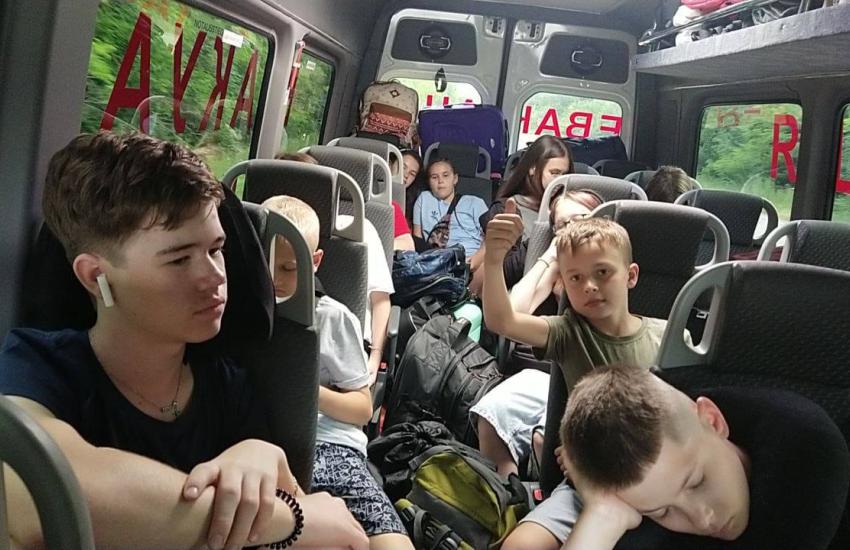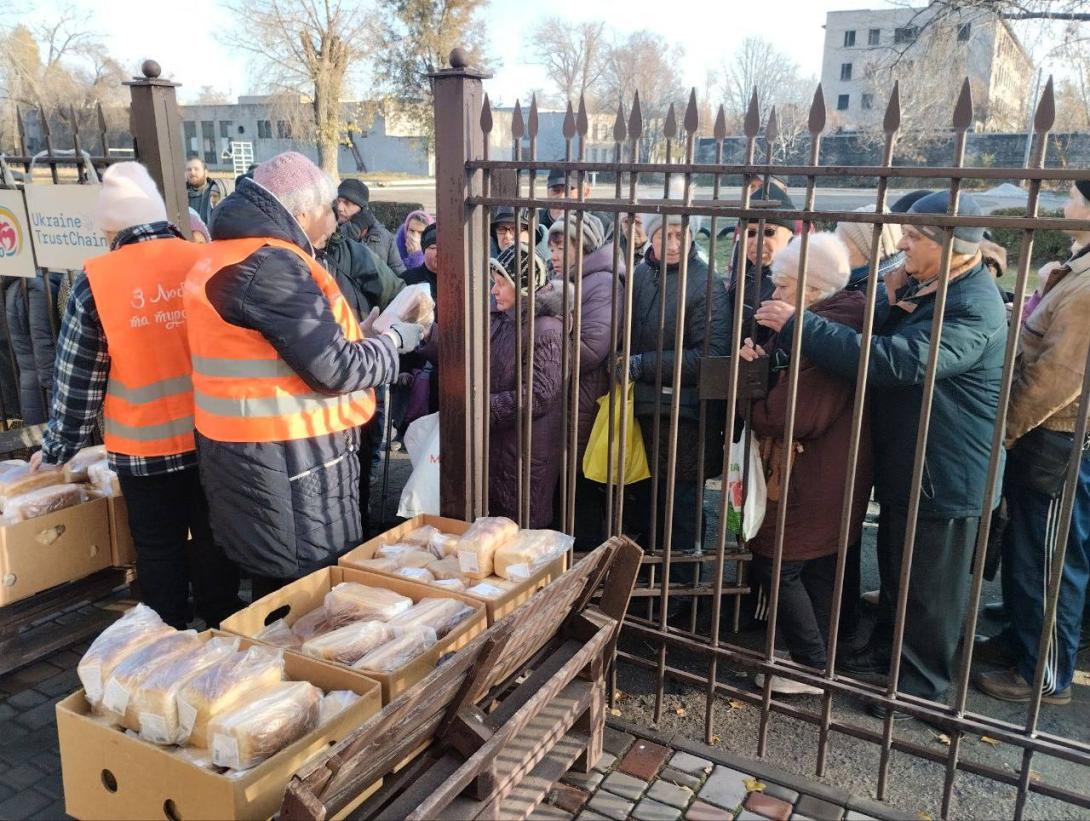Humanitarian Technology in the Midst of War
In the face of brutal, daily attacks from Russia, Ukrainian humanitarian organizations work to provide greatly needed food and assistance to their fellow Ukrainians. One such nonprofit charitable organization, Step With Hope (Крок з надією), needs digital technology to help its efforts.
The challenge is trying to operate and coordinate relief to citizens while area towns and cities are being bombed and shelled—not a great atmosphere for rolling out new technology.
Step With Hope, which was created in 2014 during Russia’s first illegal invasion of Crimea, originally served displaced citizens and families, helping them restore their psychological and physical well-being.
“We have been in existence for 10 years,” explained Pavel Belan, a volunteer with Step With Hope. “The organization started when the war began in Ukraine when Russia grabbed Crimea and invaded the eastern part of Ukraine. Back then, it was under the pretense of local rebels. But that was actually the beginning of the invasion.”
With the cruel and unnecessary full-scale invasion by Russia in 2022, Step With Hope dramatically expanded its scope, given the great need.
Step With Hope officials collaborate with local governments and other humanitarian organizations to provide or coordinate food, hygiene supplies and shelter. The organization provides eyeglasses, seeds for gardening and firewood needed for heating. In addition, the organization offers psychological support, including individual consultations, group therapy sessions and interactive events aimed at restoring emotional balance in a horrific war environment.
The organization operates from Dnipro—Ukraine’s fourth largest city located about four hours southeast of Kyiv, which is part of the Dnipropetrovsk Oblast, or province, Belan explained.
“The number of refugees and displaced people grew hundreds of times after the 2022 invasion,” he noted. “We aim to help people in as many aspects as we can, including food, housing and psychological support. We look at each person and see what we can do for them, either by ourselves, or reach out to partners if our resources are limited.”
He shared that in the cities occupied by Russia, where the residents have evacuated, the communities try to keep together at their relocated area.
In addition to helping citizens who have fled to safety, Step With Hope also operates close to the frontline to assist people who are unable or unwilling to evacuate.
“So many people are trapped,” he stressed. “Not everyone can escape. Even if they physically can go, sometimes they basically have no means to leave. Or there are villages where people say, ‘All right, we will stay here no matter what.’ Many of these villages are cut off from all supplies, with no heating. And so we bring them firewood. They can’t even get it themselves because many areas around villages were mined by the Russians, so it is unsafe to go to the forests to chop wood.”
To coordinate with local government-based centers in cities occupied by Russia, the organization relies heavily on volunteers for support.
Belan explains, “These centers are actually not on occupied territory. They are actually located on Ukraine-controlled territories and are, so to speak, ‘local community centers,’ in exile. For example, because Severodonetsk is occupied by the Russian army, their community center operates in Dnipro and serves residents from Severodonetsk who evacuated to Dnipro. We have many of those exile centers, and our organization and its volunteers cooperate with these centers.”
To communicate across its volunteer network and reach these “customers,” the organization is leveraging various technologies to communicate and manage resources and data. This includes applications such as Telegram, WhatsApp and Viber, and tailored tools such as a chatbot and a customer relationship management system (CRM).
The Center for Humanitarian Technology (CFHT), a nonprofit based in New York, has helped provide Step With Hope with a customized software bot so that the organization can provide aid to about 8,000 families a week. The so-called Telegram for Humanity chatbot was created in conjunction with the center, Automation Anywhere, Presidio and Zendesk, according to the CFHT.
The digital tool helps automate the thousands of requests for aid in a speedy and accurate manner, saving hours of manual processing time amidst war zone conditions, the CFHT noted.
The Telegram-based chatbot streamlines the registration process and schedules appointments, helping to avoid an otherwise chaotic manual process and eliminating the need for thousands of frightened people to wait in lines, Belan shared. The organization is in the process of adopting this tool.
It is important for Step With Hope to reach communities in an organized fashion and honor the dignity of the people it is serving. Offering regular meals to those in challenging life circumstances is a key priority.
“Over the last two years or so, we were able to serve close to 100,000 people,” he noted. “That would have been impossible without this technical help. The chatbot allowed us to prioritize people’s needs and make appointments. We avoided big lines of people and could handle things in an orderly, dignified manner.”
Digital tools also help Step With Hope to provide long-term support to their fellow Ukrainians. With the help of CFHT, the organization developed a CRM system to track the long-term needs of families and citizens, further amplifying its relief efforts.
“Our aim is not just to give a food parcel to a person and say ‘goodbye,’” Belan emphasized. “We want to help their children, invite them to support groups for both men and women, depending on their needs. The CRM helps us track what is happening with these people. Did they stay in our area, or did they go somewhere else? We can do data analysis about who came to us, their ages, genders, where they are from, if they still need help or if they have established themselves.”
Additionally, Step With Hope leverages other organizations’ tools. “One of the positive developments is when more organizations like ours come together,” Belan continued. “One particular one called the MCC, the Mennonite Central Committee, which operates from the Kharkiv area, they created a whole virtual hub for local humanitarian organizations to exist online. They implemented the idea of actually doing research, gathering intel and finding out information about the needs of refugees. And they even developed a whole logistical plan of evacuation of people from the war-torn areas, and we call to cooperate with them.”
The MCC also sponsors activities associated with psychological help for adults and children, and in the past two years they provided more than 100,000 parcels of food, Belan noted. Step With Hope also relies on the Ukraine Trust Chain for help with logistics. In the aftermath of a devastating flood in the Kherson area caused by an explosion of the Kakhovka Dam, and after rocket and drone attacks, the Ukraine Trust Chain has helped with urgent logistical needs.


In addition, the Canadian Food Grains Bank has assisted Step With Hope with 24,000 additional parcels of food in the last 10 months.
And given the constant threats from Russia, the organization needs reliable and safe communication platforms, especially as it coordinates with these other humanitarian groups. Security risks are at the forefront of their minds, and they are seeking more secure alternatives, said Belan. “From what we understand, Telegram is a vulnerable platform,” he shared. “And we are slowly moving more of our communication to WhatsApp,” Belan notes. “We don’t have all the answers to this question.”
The organization also tried separate commercial software solutions from Hewlett-Packard and Zendesk; however, the licensing costs proved to be too expensive. “We wish we could use platforms with U.S. origins, but many are very expensive, and we need help with that,” Belan stated. “They can help us on a pro bono basis, but only so much.”
Belan noted that Step With Hope officials will continue to harness technology to coordinate aid efforts even in the most challenging circumstances, as their work shows that in modern conflicts, digital tools are as essential as traditional aid. “Many of us wake up every day grateful that we’re alive. That’s something we’ve been living with for three years,” he stated. “The war is very, very active. It’s a very dangerous situation.”
One of their own Step With Hope personnel was killed recently when the Russians dropped a grenade from a drone that was hovering over a crowd, Belan relayed.
“That’s a threat to all our volunteers who travel to near-frontline areas,” he stated
As such, the group is looking for technologies that could help provide radio frequency technology protection and safe drone countermeasures. “We have heard of devices like a mobile mini radar that could identify a danger,” he noted. “And our volunteers would be very keen to participate in more proactive activities against drones that don’t involve firearms.”
In addition, Step With Hope wants to help empower local communities—especially those that have suffered brutal Russian occupation—to become self-sufficient through small business development, such as bread-baking shops or small sewing factories.
“But the challenge is reliable energy and heating supplies,” Belan continued. “Outages are very frequent and last sometimes for days. We are looking for energy technologies other than just petrol or diesel generators that are expensive to run.”
And the issue of mines remains troublesome. Russia placed mines heavily, especially in rural areas. As such, mine identification and other anti-mine technologies are needed.
“The scope for work here is huge,” Belan acknowledged. “And sooner rather than later humanitarian organizations like ours will have to deal with this issue because it is about safety and the overall quality of life for many people.”
Lastly, the organization will develop other systems to communicate specific needs more effectively to potential donors abroad. “When you live in a safe country, it feels like ‘everything’s fine,’” Belan noted. “But when you’re in this situation, it’s totally different. When we can communicate the needs of particular individuals or villages clearly and quickly, even ordinary people who want to help could make a huge difference. We’re not talking about millions of dollars, often much less can meet the need of a particular family.”






Comments